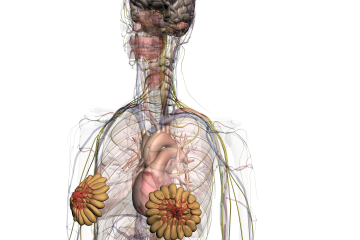The Contraindications of Exercise for the Cancer Patient
It is vital for the therapist working with cancer patients to know the contraindications of exercise, manual therapy, and modalities. In this cancer rehab continuing education course the instructor explores this topic and more.
What are the Contraindications of Exercise?
This video is from our cancer rehab continuing education course Cancer Survivorship and will provide the contraindications of exercise for cancer patients. There are a couple of contradictions to be aware of. You need to watch for DVTs and PEs and identify if the patient is on anticoagulation medications. Make sure you know their oxygen saturation levels and if they are in the normal range for activities. Is it below 90 percent? We need to take a big picture of how the patients respond during exercise. If their oxygen saturation level drops below 90 percent, you can start having them do some breathing exercises and monitor them with the pulse oximeter. You want to see the oxygen saturation level go up with the breathing exercises. Set specific oxygenation goals during exercises so the levels don’t fall below 90 percent. The exercise with monitoring involves the patient taking active participation in managing and being aware of their levels. You can provide activities where they need to keep their levels up in a certain percentage or get their levels above a certain range within a specific time or other things like that. We look at the patient’s whole picture, and that doesn’t mean that if their O2 saturation drops below 90 percent, you’re done, and you don’t work with that patient anymore. Some of these are relative contraindications, and some are absolute contraindications.
Contraindications do not necessarily mean that a cancer patient or survivor cannot exercise at all; in fact, this is rarely the case.
https://www.ncbi.nlm.nih.gov/pmc/articles/PMC3647480/
Cancer Rehab Continuing Education Course – What are the Guidelines if a Person has a Metastasis?
We talked about bone metastasis and that we need to communicate with the surgeons and oncologists to know about the integrity of the bone. Identify the results and time of their last bone density test and or scan if they have a greater than 50 percent of the cortex involved, then they cannot participate in weight exercise if less than 50 percent is involved then they can be partial weight-bearing. These guidelines also translate to the upper extremity.
Are Transfusions an Absolute Contraindication to Exercise?
Blood transfusions are a relative contraindication. We walk patients on blood transfusions in our hospital system, so it depends on your hospital’s policies. We are looking at the whole picture of the patient and the signs and symptoms they reported to you during that exercise.
What Level of Platelets are Considered safe for Exercise?
An absolute contraindication is when a patient’s platelet level drops below 20000. Low platelets put them at risk for internal bleeding. Any manual treatment or contact can cause severe bruising. When a person has anemia and the hemoglobin drops below eight, they need to report to their doctor. Again we’re looking at the whole picture. Look at the trends with their levels and check to make sure the doctors know about the changes. Make sure you communicate how the patient feels, their blood pressure, pulse oximeter level, pulse, and how they are responding to activity to the medical team. Take the vitals and report to the team.
Can you Control Orthostasis?
Another relative contraindication would be orthostasis. We can treat orthostasis with compression and with a gradual weight-bearing program, something to be aware of and consider with your cancer patient and exercise.
Some Additional Relative Contraindications
Another relative contraindication is exercising within the two hours of having a chemo infusion or within two hours of having radiation. If you prescribe exercises in that timeframe, you increase the dosage of that drug. The doctor needs to be aware of any exercises you prescribe within that timeframe. Some oncologists say do whatever, but there is literature to support that we can affect the dosage of that treatment by immediately getting them to exercise. My advice is that if you have to see the patient right after their chemo or radiation treatment, then start with something different; dont have them doing global circulation-increasing-hard exercise.
Public gyms and pools will depend on whether they are currently in chemotherapy and radiation treatments and when that chemotherapy reaches their nadir. Their doctors should be talking to them about exposure to people and the risks of being in large groups and public areas. In general no public pools at this time.
What about Exercising with a PortaCath?
Resistance exercises are an absolute contraindication for the muscle in the area of a portacath or other indwelling catheters. For example, you do not want to give a resistance exercise to the pectoralis muscle if there is a portacath in place. That can cause some issues with the circulation and could cause some clogging in those catheters.

Learn more our Cancer Rehab Continuing Education Course
Cancer Rehab Continuing Education Course Options in the Cancer/Oncology Series
Upcoming Webinar May 21, 2022 – 5 hours Learn more about the webinar
For more information on Cancer Rehab Continuing Education, go to the Healthclick All-access Online Subscription and click on the Cancer Rehab and Survivorship. Healthclick provides a series of related topics to provide a comprehensive overview from various educators.
This is one of many courses within the cancer series within the online library that addresses cancers and oncology rehabilitation. Some of the other courses that contain more in-depth evaluation and treatment techniques for overall health and functional outcomes:
Maximizing Post Surgical Outcomes in Cancer Rehabilitation
The Fundamentals of Lymphedema Treatment
The Physiological Impact of Chronic Pain
References
Eyigor S, Kanyilmaz S. Exercise in patients coping with breast cancer: An overview. World J Clin Oncol. 2014;5(3):406-411. doi:10.5306/wjco.v5.i3.406
Rajarajeswaran P, Vishnupriya R. Exercise in cancer. Indian J Med Paediatr Oncol. 2009;30(2):61-70. doi:10.4103/0971-5851.60050
Stefani, Laura & Galanti, Giorgio & Klika, Riggs. (2017). Clinical Implementation of Exercise Guidelines for Cancer Patients: Adaptation of ACSM’s Guidelines to the Italian Model. Journal of Functional Morphology and Kinesiology. 2. 4. 10.3390/jfmk2010004.
